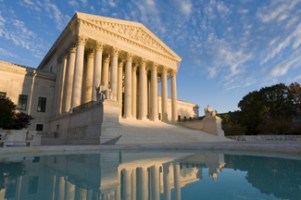SCOTUS considers death penalty case in which expert testified race could predict future violence

The U.S. Supreme Court opens its new term this month with its vacant seat unresolved, its future makeup subject to presidential politics, and a docket that—for now—is its thinnest in several years.
Nevertheless, in their first week of arguments, the justices will dive right back into the conspicuous issue of race in the criminal justice system, an issue they dealt with last term.
On Oct. 5, the court will consider the case of Texas death row inmate Duane E. Buck, who faces procedural hurdles in challenging his own trial lawyer’s decision, during the sentencing phase, to present an expert witness who predicted the future dangerousness of the defendant based in part on the fact that Buck is African-American.
The year of the trial “was 1997, not 1897; and the idea that Duane Buck’s own lawyer would present a so-called expert witness who actually said that because Mr. Buck is a black man, he is likely to be a future danger is extraordinary,” says Samuel Spital, one of Buck’s lawyers in the Supreme Court appeal.
In 2000, Texas had conceded error in a similar case in which the same witness, psychologist Walter Y. Quijano, had provided his expert opinion that a defendant’s race or ethnicity was one of the “identifying markers” of future dangerousness, which is one of the special issues a Texas jury must find before a judge may impose death.
The state appeared to promise not to oppose habeas petitions in any of six other cases in which Quijano had made similar statements. But state officials would backtrack on their willingness to consider a new sentencing hearing for Buck, and now they defend their handling of the case.
“Here, the defense’s decision to elicit testimony from its own expert reflected a considered choice and a strategic legal decision,” the state of Texas argues in a brief. “While the state cannot, and should not, raise the issue of race, defense counsel can.”
A RACIAL VIEW
Buck, now 53, was convicted in the 1995 shooting deaths of his former girlfriend, Debra Gardner, and a friend, Kenneth Butler, as well as the shooting of his stepsister, Phyllis Taylor, who survived.
At the sentencing phase, the state presented evidence that Buck had been in an abusive relationship with another former girlfriend, as well as his record of convictions on drug and weapons charges. It also pointed to the fact that Buck shot and killed his ex in front of her children and laughed while he was detained in a police car. Buck’s defense lawyers presented evidence from another psychologist that the defendant had been a model prisoner in the past and was not likely to be a future danger in prison.
The defense also presented the report and testimony of Quijano, a former psychologist for the Texas prison system who had testified as both a prosecution and defense witness at other sentencing hearings.
Quijano’s report indicated that several “statistical factors,” including a capital defendant’s past crimes, age and gender, were predictive of future dangerousness. The report identified race as another relevant factor for assessing future dangerousness, stating: “Black: increased probability. There is an overrepresentation of blacks among the violent offenders.”
Buck’s lawyer asked Quijano about those factors, and the psychologist generally tracked the conclusions of his report. On race, Quijano said, “It’s a sad commentary that minorities—Hispanics and black people—are overrepresented in the criminal justice system.”
Nevertheless, the thrust of Quijano’s testimony was that Buck was unlikely to commit future acts of violence that would constitute a threat to society, and he had adjusted well in prison, where he was not violent.
The prosecutor, in the course of cross-examining Quijano, asked one question that alluded to the race factor. “You have determined that ... the race factor, black, increases the future dangerousness for various complicated reasons; is that correct?” the prosecutor said.
“Yes,” Quijano replied.
The jury requested Quijano’s report for use during deliberations. Jurors found that Buck was likely to be a future danger, and the trial judge sentenced him to death.
CONFESSING ERROR
In 2000, while Buck’s case was on appeal, the state of Texas confessed error in another case in which Quijano had made similar race-based conclusions about future dangerousness—this time as a prosecution witness.
In court papers filed under then-state Attorney General John Cornyn, now a Republican U.S. senator from Texas, the state said the use of race in the other defendant’s sentencing “seriously undermined the fairness, integrity or public reputation of the judicial process.”
Cornyn’s office identified the six cases, including Buck’s, in which Quijano had provided testimony about race in the same way. In a separate statement to the media, Cornyn’s spokesperson said the state of Texas “would not oppose federal habeas claims for relief based on Dr. Quijano’s unconstitutional, race-based testimony in any of” those six cases.
Things changed as Buck’s case proceeded through a long appellate process. Subsequent state officials determined that Buck’s case was different because it was the only one of the six in which the defense had elicited the testimony about race. (Although Quijano had been a defense witness in two other cases in the group, a prosecutor brought out the race conclusions in those cases, the state of Texas points out.)
When one of Buck’s appeals reached the Supreme Court in 2011, the justices denied certiorari, with Justice Samuel A. Alito Jr. issuing a “statement respecting that denial,” which was joined by Justices Antonin Scalia and Stephen G. Breyer.
While Alito called Quijano’s race-based testimony “bizarre and questionable,” he said that among the six questionable cases identified by Cornyn’s office, Buck’s is the only one in which it can be said that the responsibility for eliciting the offensive testimony “lay squarely with the defense.”
Justice Sonia Sotomayor wrote a dissent from the denial, joined by Justice Elena Kagan, indicating she was troubled by the “racial overtones” of Quijano’s testimony, among other aspects of the case.
Buck’s appellate travels continued after the high court issued a decision in a 2013 case, Trevino v. Thaler, which made it easier for habeas filers to challenge the ineffective assistance of counsel even if there had been procedural defaults in their cases.
Buck filed a new federal habeas case, which a federal district judge rejected, holding that Quijano’s testimony played a minimal role in the jury’s finding of future dangerousness, among other things. The 5th U.S. Circuit Court of Appeals at New Orleans held that Buck had not made out even a minimal showing that his case was “exceptional” under the appropriate standard.
PERNICIOUS STEReOTYPE
With the Supreme Court now taking up Buck’s appeal of that ruling, his lawyers, which include the NAACP Legal Defense and Educational Fund, argue that he should be able to make his case that his “trial counsel rendered ineffective assistance by knowingly presenting an expert opinion that Mr. Buck was more likely to commit future acts of violence because he is black.
“That testimony was so directly contrary to Mr. Buck’s interests, no competent defense attorney would have introduced it,” his brief states.
“Here we have the most pernicious racial stereotype being validated by a so-called expert,” says Spital, the New York City-based Holland & Knight partner who also is representing Buck.
Deborah N. Archer, a professor at New York Law School, filed an amicus brief on Buck’s side. It stresses the historical underpinnings of American whites’ fear of blacks as dangerous and quotes President Barack Obama’s thoughts on the subject.
“This narrative of dangerousness reaches back to slavery, when black people were believed to be not just inferior but also savage brutes prone to violence and criminality unless domesticated and made docile,” says the brief by Archer and others on behalf of the National Black Law Students Association.
The Texas attorney general’s office declined to comment on the case. But in his brief on the merits, Texas Solicitor General Scott Keller concedes that under the applicable standard, “jurists of reason would at least find it debatable whether trial counsel’s performance was deficient.”
But no substantial likelihood exists that the sentencing jury would have reached a different result without Quijano’s testimony on race, Keller argues.
Prosecutors did not make inflammatory racial references but only matter-of-factly walked Quijano through his report, which covered many other subjects as well, Keller notes.
“The aggravating evidence was overwhelming,” Keller says in the brief. “Quijano’s disputed testimony played a very limited role.”
This article originally appeared in the October 2016 issue of the ABA Journal with this headline: “Future Dangerousness: Court considers death penalty case in which an expert testifies that being black is a predictor of violent behavior.”



